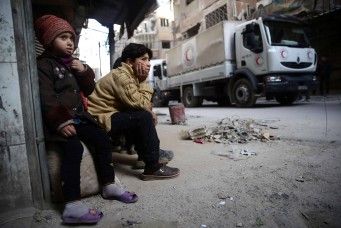Assad Letting Go of Syran Unity
Assad may be relinquishing authority over certain parts of Syria he is unable to hold or recapture, but the war is sure to drag on for some time.
Last year, several military successes tilted the political and military balance toward the Syrian regime. These included the recapture of substantial territories in the Damascus countryside between April and September, northern Hama in October, and several strategic areas along the Lebanese border—including Yabroud—in March. The Assad regime’s gains had prompted some U.S. and European policymakers to call for a partnership with Damascus—which they came to view as the strongest of the warring groups. But the recent gains made by rebel groups have proven how shortsighted proponents of regime rehabilitation were.
Successive rebel gains in strategic cities since March 2015 are in large part a result of better coordination among Saudi Arabia, Turkey, and Qatar, which had formerly backed competing opposition factions. But while the Syrian Arab Armed Forces (SAAF) increasingly exhibits signs of disintegration, it is premature to predict the imminent fall of Bashar al-Assad. The myriad rebel groups are unlikely to penetrate the regime’s core territories—from Damascus to the coastal city of Latakia via Homs, where it maintains popular support and military superiority. The regime might be unable to defend and counterattack in areas that fall outside its core territory, but Hezbollah, the Iranian Revolutionary Guard Corps (IRGC), and Iran-backed Shia militias will put up a fierce fight to maintain those defensive lines.
In the north of the country, Jaysh Al-Fatah (Army of Conquest) captured the northwestern provincial capital of Idlib in March, a significant loss for the Syrian military and paramilitary forces in the city. The SAAF’s decay was in full display much earlier, after they failed in mid-2014 to recapture the second largest city, Aleppo, which has been a battleground since 2012. Despite heavy reinforcements from Hezbollah and Iran-backed Shia militias, in early July the rebels captured the Scientific Research Center, which is one of the largest army barracks in the city. And in the south, in early June the rebel Southern Front seized a major army base in the town of Harak known as Brigade 52, one of the largest in the southern Daraa province.
These strategic losses on previously well-fortified fronts have alarmed regime ally Iran, which in recent months has ratcheted up its financial and military support to assist the weakened regime. This includes regular arms and oil shipments from Iran and a renewed Hezbollah campaign to help take border towns. But Hezbollah’s presence on several frontlines, including the Syrian-Lebanese border and areas near the Golan Heights, in most cases has not resulted in any meaningful gains for the SAAF and its paramilitaries, whose forces are overstretched throughout the country.
Until the end of 2014, the Islamic State’s (IS) threat had been confined to outlying parts of Syria outside the regime’s core territory. But in recent months, IS has intensified its attacks in Homs, Hama, Aleppo, and more recently in Damascus, despite ongoing U.S. airstrikes that indirectly benefit the regime. Their recent capture of the ancient city of Palmyra was also a strategic loss and a blow for the regime’s morale. Moreover, in late May, the regime lost its largest two phosphate mines, Sharqiya and Khnefees, to the Islamic State. Both mines were state-run and accounted for much of the regime’s last remaining exports. As most of its natural resources have fallen under the control of its opponents, Syrian state revenues have shrunk and the government is increasingly dependent on foreign backers for its survival.
But Damascus can still rely on financial aid from Tehran—including a recent $1 billion loan in May—as one of the few remaining sources of foreign currency for the regime. Since 2013, Iran has already extended loans totaling $4.6 billion, which have been largely earmarked for purchasing Iranian petroleum products. Iran has also funneled billions in weapons transfers and regular military assistance, which includes establishing and maintaining Iran-backed militias. This financial and material support will continue and likely increase following the July 14 nuclear agreement, which is expected to release more than $100 billion to Iran in sanctions relief over the next year—after the International Atomic Energy Agency verifies that Iran has complied with nuclear-related measures under the agreement.
While the SAAF itself grapples with manpower issues, non-state actors are flourishing in its absence. Military-aged Druze in Sweida and Alawites in Tartus and Latakia are becoming more defiant in their refusal to enlist in the SAAF. Instead of joining the underfunded and disjointed army, they are being cajoled into loosely organized militias funded by local businessmen and Iranian recruiters affiliated with the IRGC. These militias promise better pay and don’t demand that pro-regime communities serve outside their home regions. For example, the emergence of the “Shield Brigades” to defend Latakia and Homs has been met with little resistance from the regime.
Assad seems to understand this. On July 26, he made an unannounced speech in front of Baath party members and that was broadcast over public television, conceding that the SAAF is unable to hold on to some parts of the country and that it is grappling with desertions and defections. Contrary to his regular defiance, Assad attributed the recent military setbacks to a manpower shortage and walked back from his four-year promise to maintain a united Syria under his leadership. Although Assad may be finally relinquishing authority over certain parts of Syria he is unable to hold or recapture, the war is sure to drag on for some time to come.
This article is reprinted with permission from Sada. It can be accessed online at: http://carnegieendowment.org/sada/2015/08/04/assad-letting-go-of-syrian-unity
Rashad Al-Kattan is a political and security risk analyst, and a fellow with the Centre for Syrian Studies (CSS) at the University of St. Andrews.




